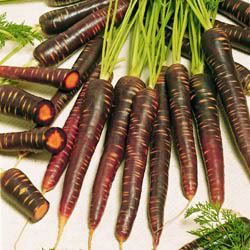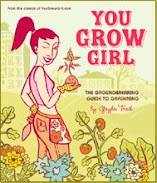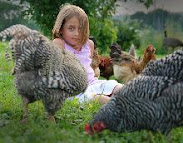My oldest son, eager to find out what life was all about in "the olden days" asked me what I did when I was his age. When I responded with "I grew up on a farm," he just about fell out of his chair. With an eyebrow raised, I got an excited chatter of entire sentences all run together about what it was all like and did I really know how to grow food, and what was this and that and the other like? With a grimace, I calmed my over excited child down and tried to answer his questions the best I knew how. This prompted us to do some shopping so we could grown our own. We found a couple of heirloom seed sites that carried the various foods that we like and discussed what we could plant now and what we wait until fall and what would wait until next year.
When my son saw these:




he just about flipped out of my chair.
Purple carrots? Really? Naw, that can't be real! But they are. Carrots were not originally orange. Those developed in Europe after the carrot made its way there from the Middle East. So now he is all about wanting to grow purple, yellow, white and red carrots so that he has a larger variety of carrots to crunch down on while watching his favorite show. If I'm not careful, both my son's will eat an entire bag of baby carrots while seated in front of the boob tube and think nothing of the fact that I had plans for those crunchy little nuggets of betacarotine goodness.
So we are all for the growing of carrots for the munchy value. Thank God I have children that will eat at least one vegetable raw without argument.
Carrots are a hardy, cool season crop that can be (and should be) planted directly in the garden as soon as the soil can be prepare in the spring. Transplanting tends to promote forking and bending so they should be planted directly. They are not drought tolerant and require even frequent waterings. They also do not do well in the heat which can cause unwanted coarseness and strong flavor. Highest root quality is achieved at around 60 to 70 degrees. Sow about two weeks before the last frost for a summer crop and for fall, sow about 2 months before the first frost of the fall. Carrots are a good spring crop but they're even better for fall planting. The flavor of fall carrots improves as the weather cools. Experts say warm days, cool nights and a medium soil temperature are the best conditions for growing great tasting carrots. Before you decide which types of carrots to plant, you have to determine what kind of soil you have.
Sowing can be interesting as the seeds are tiny. Now there are many different methods gardeners use to plant carrots -- the method you choose depends on how you want your carrots to grow.
When you plant your carrot seeds directly in your garden, make sure you work your soil early in the spring so that it is loose and well draining. Carrots require rich, healthy soil that is moist and fertile. When preparing the bed make sure you remove all large organic debris, sticks and stones. Since carrots grow underground it is important that the soil they will be pushing down into does not have anything blocking their growth. Turn the soil in the bed and rake through it several times to make sure you do not miss any large material that may be buried. The best soil for growing carrots will have plenty of organic matter worked into the seedbed before planting. Add compost to the soil a month before sowing and again two weeks after planting. It is important to avoid crusting of the soil around the seed-bed. Avoid stony, cloddy or trash-laden soils as they increase the incidence of root defects. Because raised-beds usually have loose soil and receive little compaction from foot traffic, they are an ideal location to grow carrots. Carrots grown on heavy soils may produce considerable leaf growth and forked roots. Carrot plants do not grow well in strongly acid soils; therefore, a pH range of 6.0 to 6.8 should be maintained for best results.
Sowing can be interesting as the seeds are tiny. Now there are many different methods gardeners use to plant carrots -- the method you choose depends on how you want your carrots to grow. Gardeners have taken some unusual steps to help mark the placement of carrots. Some have mixed carrot seed with coffee grounds and even sand to help spread them. There are even seed tapes that will hold the tiny seeds in place in rows. The best way to mark your carrot rows is by mixing carrot and radish seeds together. The quick-germinating radishes pop up and mark your planting. To sow the seeds individually, you take the seeds in your hand, about a half dozen at a time, and then you roll them between your thumb and forefinger planting one to two seeds 1/2-inch apart in the soil. Once the seeds are sown, you should gently pat them into the ground or you can sprinkle a 1/4-inch of fine soil to cover the bed. When planting seeds, try mixing them with dry coffee grounds to help with spacing. Another method you can use to distribute your seeds is to broadcast them. To broadcast sow carrot seed, you sprinkle or spread the seeds across the area you are planting. Seeds fall randomly and do not develop in rows. This method takes only a few seconds to do but you will have to spend more time thinning the seedling as they grow in. Be sure to cover the seeds with a fine garden soil. Never step on the carrot seed bed -- this will compact the seeds and keep them from germinating. After all the seeds are planted, you water them a fine mist and then add a light layer of pine mulch and watered lightly one more time.
Fertilizers and lime are best applied to soils for carrot production using soil test results as a guide. Arrangements for soil testing can be made through your local Extension office. Carrots require large amounts of plant nutrient elements, particularly potassium, for good production. A fertilizer with the ratio of 1-2-2 such as a 5-10-10 analysis would be appropriate at the time of seeding and again when tops are three to four inches tall and six to eight inches tall. Too much manure and fertilizer applied just before seeding can result in forked roots.
The soil that you are growing your carrots in needs to be kept moist at all times, especially when you first sow and the first seedlings appear. The key is keeping the soil moist but not water logged which encourages root hairs to branch out from the carrots. To help keep the soil moist at all times add a layer of mulch over the soil which will retain moisture. However, avoid too much moisture towards the end of the season as this will cause roots to crack. Watch for the appearance of orange crowns at the soil level as the plants mature. If this occurs, mulch with soil or compost as the sunlight will turn them green. Potential pest problems include leafhoppers, wireworms, carrot rust worm larvae, aster yellow, leaf spot and soft rot. Contact your local Extension office for current control recommendations.
Cover the seedlings with a thin layer of organic mulch such as straw or shredded bark. This will keep your soil moist while the seedlings are developing. Once your seedlings emerge, you can add more mulch around the plants. A layer of mulch about 3-4 inches deep is recommended after the seedlings emerge.
Once your seedlings begin to appear you are going to have to thin out your crop leaving only the healthiest seedlings to grow. You cannot get the best carrots if the plants are growing on top of each other, competing for the same nutrients. Thin the seedlings after three weeks so that they are about an inch apart, remember to keep the healthiest looking seedlings and cut off just the green tops of the rest. After another two weeks thin out the seedlings again to about three inches apart. These seedlings will be the carrots you harvest. As a general rule, the larger the carrot you want, the wider the spacing should be. Wider spacing also helps with an easier harvest.
Thin your carrots when they are about 1 inch tall. Be careful not to disrupt the other plants while you’re thinning your garden. Root vegetables are often sold as pelleted seeds. These seed varieties will help with even spacing and will reduce the time you spend thinning out your carrots.If you want to have carrots throughout the growing season, you can grow a new batch after the first carrots have grown for about 3-4 weeks. Carrots will germinate after about 2 weeks, and sometimes your plants will germinate unevenly throughout your garden.
Harvest can begin when carrots are finger size. In general, the smaller carrots are juicier and more tender. You do not have to harvest the entire crop at once. They can remain in the soil until you are ready to use them. Carrots will last until winter in the soil if mulched well. Carrots are best stored at temperatures near freezing in a moist environment.
Pull, don't dig, your carrots out of the ground and remove the leaves and stem of the plant. If you will not be enjoying your carrots right away leave about an inch of the stem attached to the carrot to prolong its shelf-life. Carrots destined for storage must be handled carefully during and after harvest to avoid bruising, cutting and breakage. Carrots harvested and handled in hot weather are more likely to decay and require extra care to prevent wilting. Wash carrots if they are harvested under wet conditions and are to be stored. Many potential decay-causing organisms are removed by washing. Also, clean, washed carrots allow freer air circulation. Prompt cooling to 40°F or below after harvest is essential for extended storage. Poorly precooled roots decay more rapidly.
Mature carrots are well adapted for storage and are stored in large quantities during the fall and winter. Mature topped carrots can be stored 7 to 9 months at 32°F-34°F with a very high relative humidity, 98%-100%.
Do not store carrots with vegetables and fruits that give off ethylene gas such as apples and pears. Some surface browning or oxidative discoloration often develops in stored carrots.
Diseases include: Aster Yellow, Leaf spot and Soft Rot. Pests include: Leafhoppers, Wireworms, and Carrot Rust Fly Larvae.
Use scissors to thin carrots in their earliest stages to guarantee you don't harm the adjacent seedlings as pulling them up will most likely disturb adjacent carrot roots.
If leaving carrots in the ground with mulch watch for the presence of rodents as they find carrots irresistible.
Food, Home Maintenance, eCookbook and Gracie
10 hours ago












0 comments:
Post a Comment